Recently updated on May 8th, 2025 at 04:34 am
From Patagonia’s home-style eateries to the buzzing markets of Santiago, Chile serves a vibrant spread of flavours, textures, and fresh, local produce. And, whether you’re a tastebud-traveller on a mission to discover Latin America’s most lauded fare, or refuelling as part of a more leisurely sightseeing tour, you can taste your way around a nationwide buffet of must-try bites. Get your bearings with this handy map, then follow our comprehensive guide below to cook up your ultimate Chilean-holiday hitlist.
What Makes Chilean Cuisine Unique?
Flanked by the Andes on one side and the Pacific on the other, Chile traces a long, narrow path down South America’s western edge, sharing borders with Peru, Bolivia, and Argentina. Stretching from the Atacama Desert to the wilds of Patagonia, its territory also extends into the ocean to encompass the Juan Fernández Islands and Rapa Nui (Easter Island).
This vast and varied geography provides a dynamic backdrop for a culinary landscape shaped as much by its diverse growing regions as by its layers of indigenous, Spanish, and immigrant influences. In the central region, particularly around Santiago, you’ll find a modern dining scene where fine-dining and street eats converge, blending bold Andean traditions and international influences with contemporary flair. In the nearby coastal and wine regions of the Maipo and Casablanca valleys, bold reds and vibrant whites complement pasture-raised meats, seafood delicacies like conger eel, sea urchins, and shellfish, and fresh garden vegetables like corn and potatoes. Heading south into the Lakes, Tierra del Fuego and Patagonia regions, traditional slow-cooked stews and lamb are local specialties, with meats often grilled over open-flame parrillas or cooked in traditional pits called curantos. Meanwhile, along the northern coast near the Atacama Desert, and on Rapa Nui, yellowfin tuna, trevally, sea bass, and scorpionfish are particularly prized.
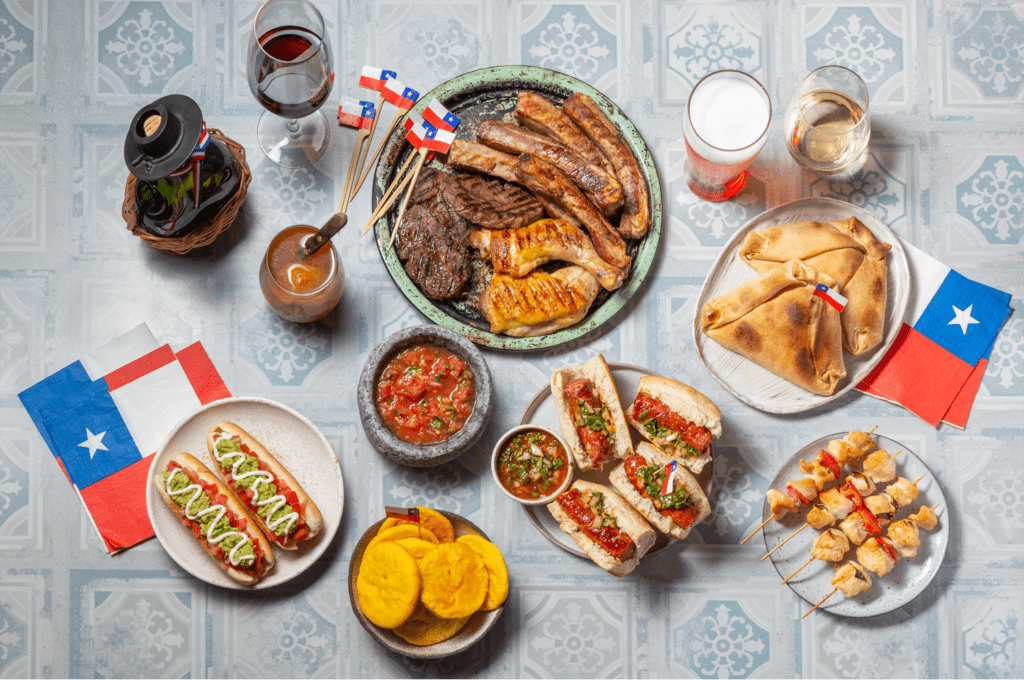

Must-Try Chilean Starters & Street Foods
Whether you’re snacking on the go or stoking your appetite for the feast ahead, Chile’s street-eats, light bites and share plates deliver bold flavours and regional flair.
Empanadas
These hand-sized savoury pastries can be filled with a variety of ingredients but the most famous is pino: a mixture of seasoned beef, sautéed onions, hard-boiled egg, black olives, and sometimes raisins. They’re baked or fried until golden and widely enjoyed across the country.
Pebre
A zesty mix of tomatoes, onions, coriander and chilli, this ubiquitous salsa-style condiment adds a fresh kick to everything from empanadas to grilled meats and breads – and is a familiar fixture on restaurant tables across the nation.
Sopaipillas
Deep-fried, flat, crispy scones made from pumpkin and flour, these can be drizzled with spiced syrup for a sweet treat or topped with pebre for a savoury snack.
Completo
Chile’s take on the hot dog, the completo, is as much about the toppings as it is the meat – usually a standard Frankfurt-style sausage made from beef, pork, or both. Served in a long, soft bun, it’s typically loaded with a towering stack of mashed avocado, chopped tomatoes, mayonnaise, and, depending on the vendor, mustard or sauerkraut.
Chorrillana
This casual comfort-food dish is a pub-grub staple made for sharing, layering crispy potato fries with sautéed beef, fried onions, and either scrambled or fried eggs. Sometimes sausages or melted cheese are added for extra indulgence.
Explore Chile’s legendary Casablanca and Maipo wine regions, Torres del Paine, the Atacama Desert, and beyond on our customisable Authentic Chile adventure.
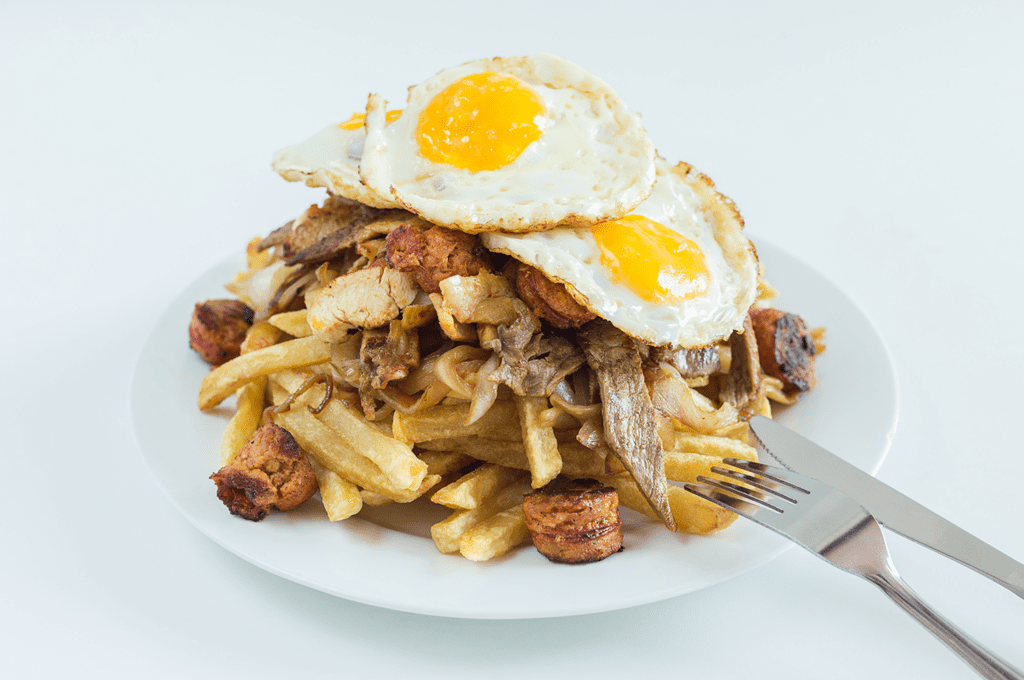

Classic Chilean Main Dishes
Generally, Chile’s traditional mains are shaped by its seasonal, regional produce, traditional slow-cooking and flame-grilling techniques, and served in generous portions.
Pastel de Choclo
This sweet-meets-savoury pie layers ground beef, onions, black olives, hard-boiled eggs, and chicken, all topped with a blended corn and basil mixture. Baked until golden, it forms a crispy crust with a soft, creamy centre, and is sometimes lightly dusted with sugar before going in the oven.
Cazuela
A classic, clear homestyle soup made with beef or chicken, along with chunks of potato, pumpkin, corn on the cob, carrots, green beans, and either rice or noodles, all lightly seasoned with parsley and oregano.
Charquicán
Hearty and homey, this slow-cooked stew combines beef, potatoes, carrots, green beans, pumpkin, corn, and spices, and is often topped with a fried egg. Traditionally made with dried meat (charqui), modern versions usually use beef mince or leftover roast.
Pollo Arvejado
This comforting stew is made from simmered bone-in chicken (pollo), peas (arvejas), and slow-cooked vegetables like onions, garlic, carrots, and sometimes capsicum. Served with rice or potatoes, it’s a family favourite.
Chacarero
A traditional sandwich with a zingy kick, the chacarero layers thinly sliced grilled beef or pork with tomatoes and green beans inside a soft bread roll. Often dressed with chilli, mayonnaise or avocado, it’s a popular lunch choice across the country, but especially common in Santiago.
Adventure World’s 10-day Insider Chile journey is a delicious immersion in flavour, nature and culture.


Seafood Specialties of the Chilean Coast
Sourced from its offshore reaches and more than 6,400km of mainland coastline – from the southern regions of Tierra del Fuego and Patagonia to the warmer waters off remote Rapa Nui and the Atacama Desert – Chile’s ocean fare is briny-fresh, succulent, and regionally nuanced.
Centolla
Centolla, or Chilean king crab, is a prized delicacy from the cold southern waters of Patagonia, particularly around Punta Arenas and Tierra del Fuego. Its sweet, tender meat is often presented simply – steamed or boiled, then served with lemon, butter, or mayonnaise – but it also stars in richer dishes like chupe de centolla (a creamy crab bake), and as an empanada filling.
Machas a la Parmesana
A favourite along Chile’s central coast – particularly in seaside towns like Viña del Mar and Valparaíso – machas a la parmesana takes tender pink razor clams and bakes them on the half shell with butter, white wine, and a generous topping of Parmesan or another cheese.
Caldillo de Congrio
Especially beloved in seaside towns like Valparaíso, Coquimbo, and Puerto Montt, this rich fish stew is made with conger eel, simmered in a tomato-based broth with onion, garlic, carrots, potatoes, herbs and, occasionally, a splash of white wine.
Curanto
A traditional feast from Chiloé – an island off southern Chile – curanto layers shellfish, meats, potatoes, and vegetable patties over hot stones, steaming everything beneath nalca leaves. Smoky and filling, it’s a communal dish tied to local festivals and family gatherings, with a pot-cooked version known as curanto en olla common on the mainland.
Locos
These prized Chilean-native sea snails are especially popular in the south and in higher-end restaurants along the central shoreline. Their firm, mild-flavoured flesh is traditionally boiled until tender, then chilled, sliced, and plated up cold with mayonnaise and lemon.
Easter Island is a feast for every sense – as you’ll experience on our 5-day fully customisable Explora Rapa Nui journey.
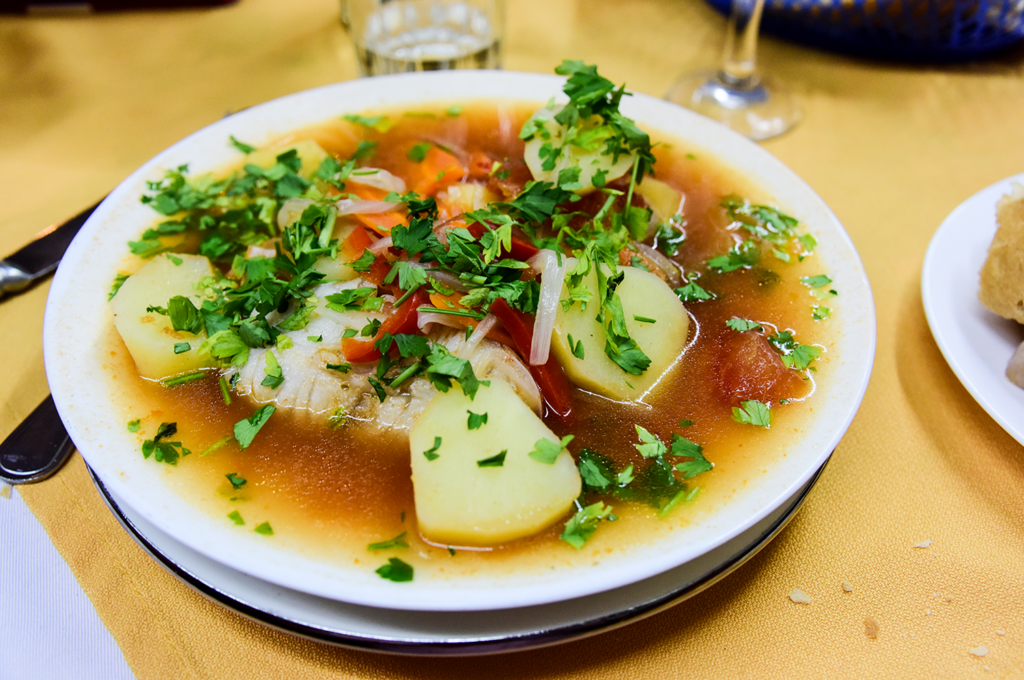

Traditional Chilean Soups & Stews
Simmered slowly and served generously, Chile’s soups and stews draw on Indigenous ingredients and are adapted to its diverse altitudes, latitudes, and cultural influences. These are home-style comfort recipes that are passed down from one generation to the next and enjoyed as both weekday staples and celebratory centrepieces.
Ajiaco
A popular comfort food in central Chile, this rustic beef and potato soup often makes use of leftover meat, especially after a barbecue (asado). Onions, garlic, carrots and green beans, oregano and parsley may also be added.
Carbonada
Common throughout Chile, with ingredients adjusted to suit the seasons, this traditional beef soup combines tender beef chunks with rice and vegetables like potatoes, butternut squash, carrots, corn, and green beans. Everything is simmered in a flavourful broth seasoned with paprika, oregano, and cumin.
Porotos Granados
A homey, vegetarian stew popular in central and southern Chile, porotos granados combines tender Borlotti beans with corn, squash, tomatoes, onions, and seasonings like basil and paprika. It’s usually served with crusty bread or a simple salad.
Chupe
Seafood (usually crab or prawns), soaked bread, cream, sautéed onions, and melted cheese come together in this rich, baked casserole, beloved all along Chile’s shoreline but especially in the south.
Pataska
A traditional dish from Chile’s Atacama region, pataska is a filling hominy (dried maize) stew popular in the northern Andean villages like Chiu-Chiu. It combines the hominy with lamb, beef or pork, potatoes, pumpkin, and roasted yellow chilli, then simmers it all together with garlic, cumin, and fresh herbs.
Fire up your tastebuds and inspiration with a 5-day stay at spectacular Nayara Alto Atamaca.
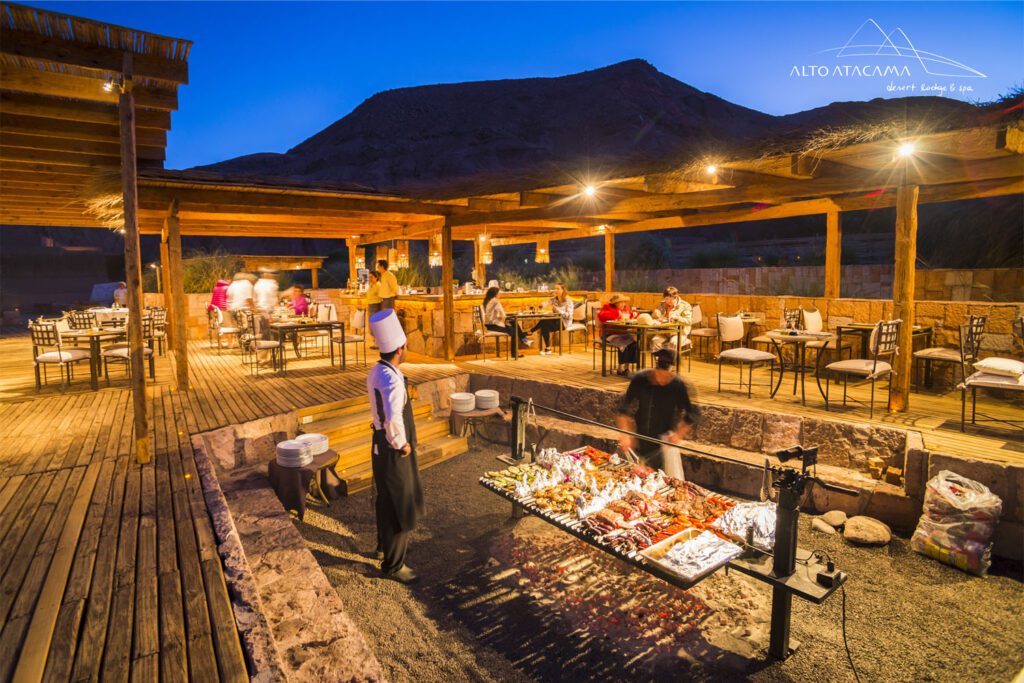

Chilean Desserts & Sweet Treats
Chilean desserts are typically reserved for lunch or special occasions rather than everyday dinners, and ingredients follow the seasons and regions. In the central valleys, sweets highlight orchard-grown stone fruits, citrus, and nuts, while the southern regions favour heavier baked treats and rich fillings suited to colder temperatures. In the arid north, desserts are lighter and adapted to the high-altitude climate, often relying on dried or native fruits (like chañar) and natural sweeteners made from them.
Manjar Blanco
A caramel-like spread made from slowly cooked sweetened condensed milk, this Chilean staple is often flavoured with a hint of cinnamon or vanilla, and features in all sorts of desserts and bakery morsels. If you’re not keen to taste it straight from the spoon, try it on pancakes or toast, or in alfajores, where it’s sandwiched between two soft biscuits and rolled in coconut.
Pan de Pascua
Despite its name meaning ‘Easter bread’, this dense, spiced fruitcake is Chile’s go-to Christmas treat. It’s studded with candied fruits, raisins, walnuts and almonds, and flavoured with cinnamon, cloves, and a splash of rum or pisco.
Mote con Huesillos
This traditional non-alcoholic summer drink is especially popular in central Chile, where it’s sold from street carts. It combines soft-cooked wheat berries (mote) and rehydrated dried peaches (huesillos) in a spiced syrup made with cinnamon, sugar, and sometimes a touch of orange peel. Served chilled, it’s a tangy, refreshing way to beat the heat.
Dine amongst the glaciers, mountains and crystal-clear lagoons of Earth’s end with our 5-day Explora Torres del Paine holiday.
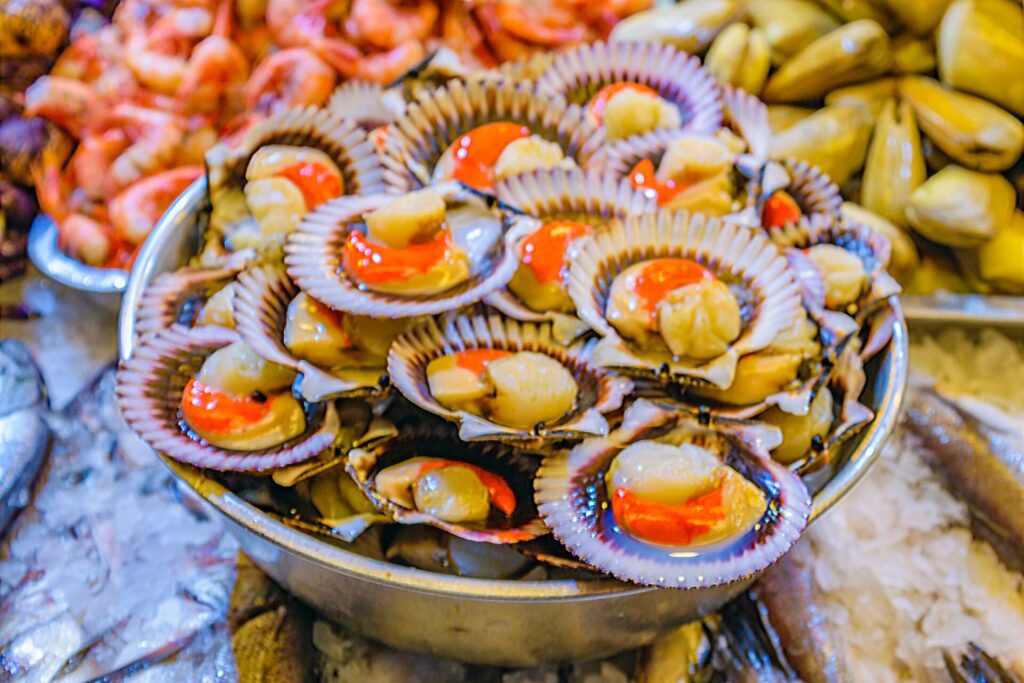

Where to Try These Dishes in Chile
From high-end restaurants to beloved local joints, Chile has an eatery to suit every taste and budget. Locals flock to picadas (informal neighbourhood spots) and comedores (simple, home-style diners) for comforting, authentic meals, while bustling cocinerías inside markets serve traditional stews and bean dishes. For something fast and filling, sangucherías (sandwich shops) and fuentes de soda (retro-style diners) deliver Chilean classics, and along the coast, there’s a marisquería (seafood restaurant) for every palate and price point. Here, a few more places where you can sink your teeth into a foodie favourite:
Local Markets
In Santiago, La Vega Central is the city’s primary produce market, home to more than 500 stalls brimming with fresh fruits, vegetables, meats, and dairy, plus a host of eateries serving authentic Chilean meals at bustling counters or to go. Nearby, Mercado Central is renowned for its seafood, striking ironwork architecture and buzzing atmosphere. Further south, Puerto Montt’s Angelmó fish market and Mercado Presidente Ibáñez both offer a glimpse of the region’s seafood and farm-fresh fare.
Iconic restaurants
While there’s no shortage of eateries to choose from, here’s a few for your to-do list… In Santiago, Boragó highlights native ingredients and consistently ranks in the world’s top restaurants, while Ambrosia offers a contemporary twist on the Chilean classics to emphasise seasonal produce. Within two hours’ drive of the city, the Casas del Bosque winery’s restaurant, Tanino, pairs modern local dishes with their own Casablanca Valley vintages, while on the coast, local seafood sings on the menus of Restaurant La Concepción and in World Heritage-listed Valparaíso. Further afield, Estancia Cerro Guido’s restaurant in Torres del Paine serves simple-but-elegant meals with ingredients hand-picked from their greenhouse and orchard, while in San Pedro de Atacama, Baltinache elevates local flavours and regional ingredients in the heart of the desert.
Authentic foodie experiences
Across Chile, unique culinary activities level up your adventure. While staying at Hotel Las Patagonia, you can explore the Las Torres Reserve Regenerative Kitchen Garden, where expert gardeners share their ages-old techniques rooted in sustainability and bio-intensive practices. As one of the world’s southernmost regenerative gardens, it yields seasonal fruits and veg that star in the authentic Patagonian, farm-to-table menu of its on-site Coirón Restaurant. And in the heart of the Maipo Valley wine country, you can Make Travel Matter with a visit to Fundación Origen. This extraordinary non-profit organisation is committed to community development, with its own school to educate youngsters about sustainable farming and environmental health.
Regional Food Festivals
For a deeper dive into Chile’s customs and flavours, time your holiday to coincide with special events when the locals are celebrating their cultural and culinary heritage. Visit Arica in February for Latin America’s third-largest carnival, showcasing Andean culture with traditional food, music, dance, and vibrant parades. From February to May, the wine regions come alive with vendimias, or grape harvest festivals, with a host of activities like grape-stomping, gastronomic fairs, artisan markets, live music, and wine tastings, especially in the Casablanca and Maipo valleys. Still thirsty? Clink glasses at Bierfest Kunstmann, Valdivia’s four-day beer festival. And, for round-the-clock celebrations, visit in September when the whole country celebrates its independence with its Fiestas Patrias festival.
Savour the gastronomical traditions and natural playgrounds of Torres del Paine with a 5-day immersion at Hotel Las Torres.
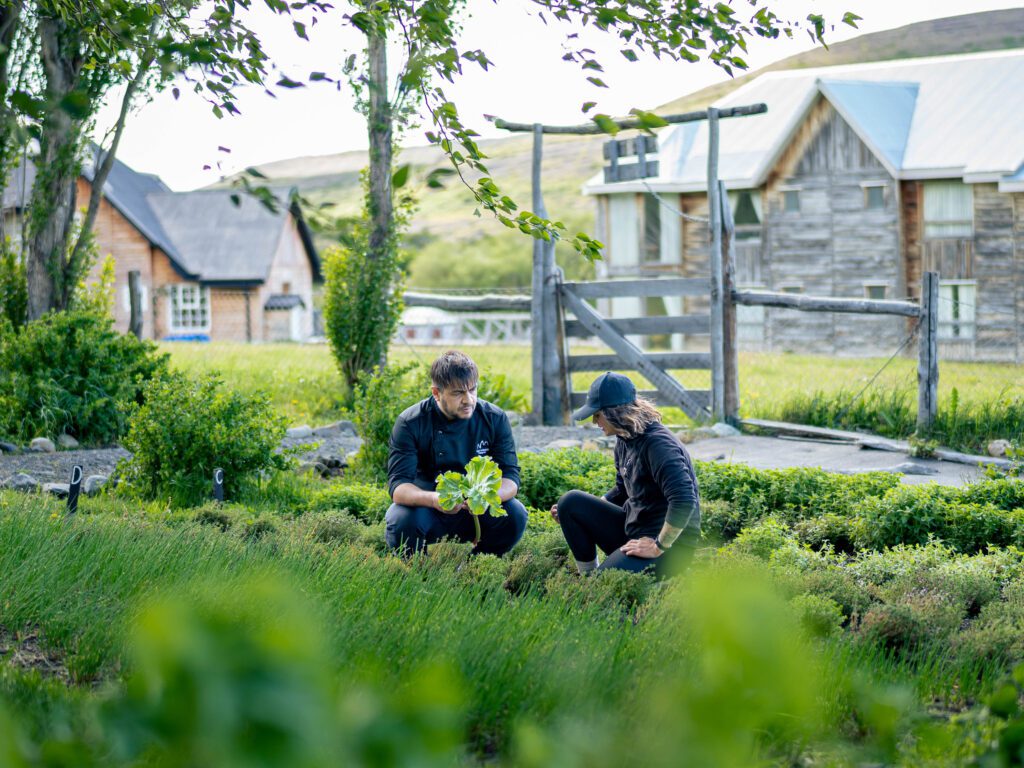

Final Tips for Enjoying Chilean Cuisine Like a Local
Here, 6 simple ways to enhance your dining experiences…
- Remember, you only live ‘la once’. In Chile, la once is a light evening meal served around 5-7pm, often replacing dinner with a spread of light bites, bread, cheese, cold cuts, and tea.
- Taste the terroir every day. Wine is widely sipped at mealtimes, not just on special occasions. And it’s not surprising, really, as Chile’s viticultural regions produce a vast variety of drops that pair perfectly with local dishes. Read our guide, The World’s Best Wine Regions for a Gourmet Holiday, for a taste of the Maipo and Casablanca valleys.
- Roll with the marraqueta. Crusty on the outside with a light and fluffy centre, the marraqueta – Chile’s favourite bread roll – is served with breakfast and la once.
- Sip something new. Pisco isn’t just a grape-based brandy, it’s a source of Chilean pride as locals lay claim to its origin over neighbouring Peru. Try it on its own or mixed with lemon juice (pisco sour) or fizzy cola (piscola). Game for a deliciously potent drop? Try a terremoto. This traditional cocktail is also known as an ‘earthquake’, made with sweet fermented pipeño wine, pineapple ice cream, and grenadine.
- Accept every asado invitation. Asados, or traditional Chilean barbecues, are lively get-togethers where various meats like beef, pork, chicken, and sausages are grilled slowly over charcoal or wood embers, then shared with friends and family. Reflecting the community spirit of these gatherings, it’s polite to arrive with a side dish or drinks to share (think: a bottle or two of red or Pisco; a simple salad, dessert, or fresh marraquetas).
- Learn the right way to eat and greet. During your meal, you may hear ‘¡Buen provecho!’– a common, friendly way to say, ‘Enjoy your meal’.
